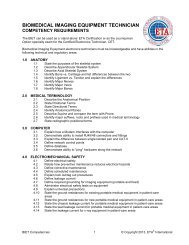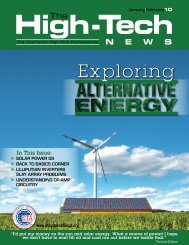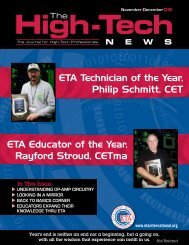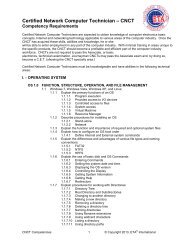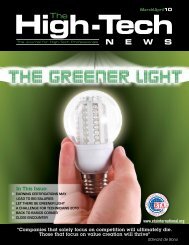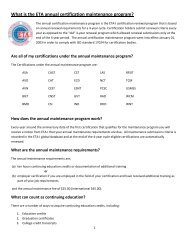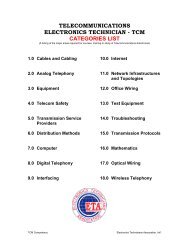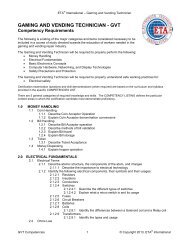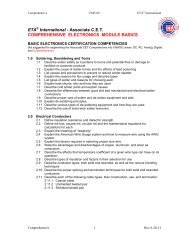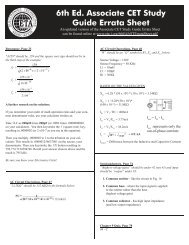ELECTRIC VEHICLE TECHNICIAN (EVT) - ETA International
ELECTRIC VEHICLE TECHNICIAN (EVT) - ETA International
ELECTRIC VEHICLE TECHNICIAN (EVT) - ETA International
Create successful ePaper yourself
Turn your PDF publications into a flip-book with our unique Google optimized e-Paper software.
<strong>ELECTRIC</strong> <strong>VEHICLE</strong> <strong>TECHNICIAN</strong> (<strong>EVT</strong>)Competency requirementsThe <strong>EVT</strong> basic competencies shown here were produced by the <strong>ETA</strong> <strong>EVT</strong> committeemembers and the staff of <strong>ETA</strong> in Greencastle, Indiana. They are shown first asCATEGORIES of knowledge, then the Individual ITEMS (pg.2) that are important underand related to each Category. Then the Items are verbalized as COMPETENCIES (pg.8).These describe for each item what a technician must know or have an ability to interactwith in performing his/her job as an EV technician.<strong>ELECTRIC</strong> <strong>VEHICLE</strong> <strong>TECHNICIAN</strong>CATEGORIES LIST:1.0 Safety Requirements2.0 Electric Vehicle Fundamentals3.0 Electrical Theory4.0 Electronic Systems Components5.0 Motor Theory6.0 EV Electronics and Testing Fundamentals7.0 Batteries8.0 Energy Delivery Systems9.0 Charging10.0 BEV Maintenance and Troubleshootingrev.9-20-12; <strong>EVT</strong> Competencies 1 © Copyright 2013, <strong>ETA</strong> ® <strong>International</strong>
Electric Vehicle Technician (<strong>EVT</strong>)<strong>ETA</strong> ® <strong>International</strong><strong>ELECTRIC</strong> <strong>VEHICLE</strong> <strong>TECHNICIAN</strong>ITEMS LIST:(Topics of knowledge required by EV technicians)1.0 SAFETY REQUIREMENTS1.1. Personal Protection Equipment (PPE)1.1.1. High Voltage Electrical Glove rating system1.1.2. Dangers of working around high voltage1.1.2.1. Arc Flash, Arc Blast1.1.3. Shop protection equipment requirements1.1.4. Electrical Meter safety requirements and standards1.1.5. PPE required practices1.2. OSHA Requirements on High Voltage1.2.1. Basic OSHA High Voltage electrical standards1.2.2. Cable color-code system associated with levels of voltage1.2.3. Vehicle work area set up1.3. Electrical Shock Prevention1.3.1. Personal safety precautions - accident mitigation1.3.2. ‘One Hand’ rule for working on electrical equipment1.3.3. ‘Never Work Alone’ concept1.4. Electrical Shock Response1.4.1. Human physiological reactions to electrical shock1.4.2. Degrees of current the human body can tolerate1.4.3. First Aid for electrical shock victims1.4.4. Dangers involved with artificial respiration1.4.5. Dangers involved in detaching a shock victim from the source of voltage1.5. High Voltage Safety1.5.1. High Voltage components and connections1.5.1.1. Safety Interlocks (including high voltage)1.5.1.2. Service plugs and receptacles1.5.1.3. High voltage service disconnect1.5.1.4. High voltage fuse1.5.1.5. Ignition key block1.5.1.6. Battery connections1.5.1.7. Charge port1.5.1.8. Charge controller1.5.1.9. DC/DC converter1.5.1.10. Inverter/motor controller1.5.1.11. Traction motor1.5.1.12. Air conditioner1.5.1.13. Power steering1.5.2. DC current leakage in an EV1.6. Fire Safety1.6.1. Different classes (A, B, C, D, & K) of fires1.6.2. National Fire Protection Association (NFPA ® ) extinguisher types andcombinations1.6.3. Fire safety regulations of the NFPA ® 70, National Electrical Code (NEC ® )pertinent to electric vehicles1.6.4. Fire extinguishing procedures1.7. Explain Emergency Response Guides (ERG), overview familiarization1.7.1. Vehicle Emergency Response Guide Information1.7.2. First Responder extraction process1.8. Battery Safety1.8.1. Flooded Lead Acid(FLA) gas hazardsrev.9-20-12; <strong>EVT</strong> Competencies 2 © Copyright 2013, <strong>ETA</strong> ® <strong>International</strong>
Electric Vehicle Technician (<strong>EVT</strong>)<strong>ETA</strong> ® <strong>International</strong>1.8.2. Flooded Lead Acid(FLA) spill hazards1.8.3. Absorbed Glass Mat(AGM) hazards1.8.4. Battery Pack Isolation (Short Circuit or Grounding Hazard)1.8.5. Nickel- Metal Hydride hazards1.8.6. Lithium-Ion hazards1.8.6.1. Thermal runaway prevention2.0 <strong>ELECTRIC</strong> <strong>VEHICLE</strong> FUNDAMENTALS2.1 History2.1.1 Battery development2.1.2 EV economics, environmental factors and range anxiety2.1.3 Internal combustion engine (ICE) vehicles vs. electric vehicles2.2 EV Operations2.2.1 Power regeneration basics2.2.2 EV components2.3 Basic wiring systems2.3.1 EV/ICE block diagram comparison2.3.2 Schematic wiring, schematic component/connection identification2.4 EV Conversions/hybrids2.4.1 EV conversion history2.4.2 EV conversion basics2.4.3 Hybrid vehicle history2.4.4 Hybrid basics2.4.5 Factory/aftermarket conversion factors3.0 <strong>ELECTRIC</strong>AL THEORY3.1. Mathematics for Electronics3.1.1. Math for electronics3.1.2. Basic algebraic math for electronics3.1.3. DC electronics’ scientific symbols3.1.4. Scientific notation3.1.5. Metric prefixes:Peta, Tera, Giga, Mega, Kilo, mili, micro, nano, pico3.1.6. Standard metric conversions3.2. Ohm’s Law3.2.1. Ohms law3.2.1.1. Resistance3.2.2. Watts Law3.2.2.1. Voltage3.2.2.2. Power3.2.2.3. Current3.2.3. Kirchhoff's Law3.2.3.1. Current Divider Calculations3.2.4. Energy Units3.2.4.1. Kilowatt/hrs3.2.4.2. Joules3.3. Voltage drop meter measurements3.3.1. Electronic measurements using meters:3.3.1.1. Current3.3.1.2. Voltage3.3.1.3. Resistance3.3.1.4. Power3.4. Series circuits3.4.1. Series circuit schematic in DC electronic equipment3.4.2. Resistance in a series circuit3.4.3. Current, voltage or resistance in a series circuit calculationrev.9-20-12; <strong>EVT</strong> Competencies 3 © Copyright 2013, <strong>ETA</strong> ® <strong>International</strong>
Electric Vehicle Technician (<strong>EVT</strong>)<strong>ETA</strong> ® <strong>International</strong>3.5. Parallel circuits3.5.1. Parallel circuit as used in DC electronic equipment3.5.2. Total resistance of a parallel circuit calculation3.5.3. Current calculation in a parallel circuit using the current-divider rule3.6. Principles of Alternating Current (AC)3.6.1. AC wave form characteristics:3.6.1.1. Effective voltage (RMS)3.6.1.2. Average voltage3.6.1.3. Negative Alternation3.6.1.4. Positive Alternation3.6.1.5. Wavelength3.6.1.6. Amplitude3.6.1.7. Period3.6.2. Peak, RMS, and average voltage values for an AC waveform3.6.3. Frequency terms:3.6.3.1. Duty Cycle3.6.3.2. Hertz3.6.3.3. Phase4.0 ELECTRONIC SYSTEM COMPONENTS4.1 DC and AC isolation detection circuits4.1.1 DC leakage from high voltage4.1.2 Resistance and Capacitance testing for leaks4.2 Isolation fault circuit4.2.1 Resistors or Op-amps4.3 Voltage sensing stages4.3.1 Voltage comparators, voltage regulators4.4 Logic / Digital output stages4.4.1 Binary and Analog serial data4.5 Voltage regulator circuits4.5.1 Zener diode4.6 Motor Power Control strategies IM /PM power inverter4.6.1 Software algorithms4.7 Instrumentation4.7.1 Controlled Area Network (CAN)5.0 MOTOR THEORY5.1 Basic DC Motor theory5.1.1 DC motor types5.1.2 Back electromotive force (CEMF)5.1.3 Brushless motors (PM/BLDC) (permanent magnet/brushless DC motor)5.2 DC motor types and usages5.2.1 Segmented laminated core5.2.2 Rotor magnetic design (V vs. rectangular shape)5.3 DC Motor Math5.3.1 DC motor math formulas5.3.2 Input current/voltage5.4 Output torque/speed-motor basics5.4.1 Right-hand rule for motors5.5 No load rule5.5.1 No load rule: w =V/k5.6 Controls5.6.1 Permanent magnet electric controls5.6.2 Synchronous field control5.7 P/M machine stator design5.7.1 Stator switching pointrev.9-20-12; <strong>EVT</strong> Competencies 4 © Copyright 2013, <strong>ETA</strong> ® <strong>International</strong>
Electric Vehicle Technician (<strong>EVT</strong>)<strong>ETA</strong> ® <strong>International</strong>5.7.2 Air gap magnetic fields5.7.3 Stator field generation5.7.4 Flux vector control5.8 Windings5.8.1 Distributed windings5.8.2 Concentrated windings5.8.3 Frogleg windings5.9 Motor phase5.9.1 Phase change as it applies to EV motors6.0 EV ELECTRONICS AND TESTING FUNDAMENTALS6.1 Test Equipment6.1.1 How to use the following High Voltage Analysis Tools:6.1.1.1 Digital Volt Ohm Meter, (DVOM)6.1.1.2 Oscilloscope6.1.1.3 Differential Scope Probe6.1.1.4 Digital Scope6.1.1.5 Insulation Meter6.1.2 Differences between multimeter test leads: ordinary vs. high voltage6.1.3 Test equipment detecting resistance and capacitance leaks6.2 CAT I electronics6.2.1 Categories of voltages found in EVs6.3 Transformer high voltage winding-resistance6.3.1 Purpose and method of measuring transformer windings in EVs6.4 CAT II electronics6.4.1 CAT II electronics as used in EVs6.5 Receptacle-connected loads6.5.1 Receptacle-connected loads used with EVs6.6 CAT III electronics6.6.1 CAT III electronics as used in EVs6.7 Equipment in fixed installations6.7.1 Fixed installations applying to EV systems6.7.2 Rules and precautions related to EMI in fixed installations6.8 CAT IV electronics6.8.1 Differences between the levels of CAT electronics and how CAT IV is related toCAT 1, 2, and 3 in EVs6.9 Utility connection between pole and meter6.9.1 Connection between pole and meter required for charging stations intended forEVs6.10 Ground paths through meters6.10.1 EV ground paths and why minimization is required7.0 BATTERIES7.1 Battery Ratings:7.1.1 State of Charge (SOC)7.1.2 Equations used in Ohms Power Law: P = E x I7.1.3 Depth of discharge (DOD)7.1.3.1 Bricking7.2 Service Disconnects7.2.1 Manual disconnect (MSD)7.2.2 Power disconnect (PSD)7.2.3 Service disconnect, (SDC)7.3 Voltage Isolation Faults7.3.1 Low power monitoring devices and their usage7.3.2 Voltage sensing stage (resistor dividers)rev.9-20-12; <strong>EVT</strong> Competencies 5 © Copyright 2013, <strong>ETA</strong> ® <strong>International</strong>
Electric Vehicle Technician (<strong>EVT</strong>)<strong>ETA</strong> ® <strong>International</strong>7.4 Battery construction7.4.1 Flooded lead acid, absorbed glass mat and gel cell batteries7.4.1.1 Gas recombination as used in EV batteries7.4.2 Lithium-Iron Phosphate (LiFePO 4 ) Batteries7.4.3 Nickel-Metal Hydride (Ni-MH) Batteries7.5 Capacity rate and amp-hour rate of batteries7.5.1 Energy and power density in EV batteries7.5.2 Specific energy and power7.5.3 Effects of temperature on the state and depth of charge7.6 Charge and discharge characteristics7.6.1 Charge and discharge characteristics of EV batteries7.6.2 Discharging Station/Charger7.7 Battery Management Systems7.7.1 Battery coolant systems used in EVs7.7.2 Forced air coolant systems used in EVs8.0 ENERGY DELIVERY SYSTEMS8.1. AC and DC Motor controls8.1.1 Four functions of EV motor controllers8.1.2 Current limit technology on inrush during start8.1.3 Jogging and inching functions in EVs8.1.4 Reversing controls8.2 Inverter Controls8.2.1 Transistor types utilized in EV inverters8.2.2 Different waveforms used in EV control circuitry8.2.3 Sine and six-step waveform creation8.2.4 Calculating rotor frequency and motor speeds8.3 DC/DC converters8.3.1 Pulse width modulation (PWM) used in DC/DC converters8.3.2 Functions of DC/DC converters in EVs8.3.3 Step down (buck) and step up (boost) functions of converters8.4 Transaxle design, (gears, torque)8.4.1 Gear ratios as used in EV transaxles8.4.1.1 Torque multiplication8.4.2 Continuously variable transmissions in EVs8.4.3 Differentials as used in EVs9.0 CHARGING9.1 DC/DC Converters9.1.1 Basic operating cycles of a DC/DC converter during charging9.2 Charging Levels9.2.1 Voltage and ampere/hour limits of level I EV charging9.2.2 Voltage and Ah of level II charging systems9.2.3 Voltage and Ah of level III charging systems9.2.4 Purposes and requirements of fast charge systems9.2.4.1 CHAdeMO usage, level and advantages9.2.5 Power input requirements for Level 1, 2 and 3 charging systems9.3 On-board chargers9.3.1 Parallel and Series paring in BEV (battery electric vehicles)9.3.2 Voltage sensing as utilized in EVs9.4 Off vehicle chargers9.4.1 Charger Connectors9.4.1.1 SAE J1772 Standards for charger connectors9.4.1.2 Other contact connectors for EVs9.4.1.3 Inductive charging systems for EVs9.4.2 Electric Vehicle Supply Equipment, (EVSE)rev.9-20-12; <strong>EVT</strong> Competencies 6 © Copyright 2013, <strong>ETA</strong> ® <strong>International</strong>
Electric Vehicle Technician (<strong>EVT</strong>)<strong>ETA</strong> ® <strong>International</strong>9.4.3 No-start features for EVs9.4.4 Micro switch connections used in EV charger systems9.5 Off Grid chargers (zero carbon footprint)9.5.1 Photovoltaic power generation as used in EVs9.5.2 Wind power generation use in EVs9.6 Vehicle to Grid9.7 Mini-EV Charging controls9.7.1 Charge levels offered by different charge systems9.8 Regeneration9.8.1 EVs utilization of regeneration to reduce power consumption10.0 BEV MAINTENANCE AND TROUBLESHOOTING10.1 CAN bus10.1.1 CAN - controller area networking system10.1.2 OBDII error codes10.2 Generic system controls10.2.1 High voltage shut down system10.2.2 (Interlock systems) operation in EVs10.3 Cooling system10.3.1 Service procedures unique to EVs10.3.1.1 Active and passive HVAC systems10.3.2 Proper PH levels in EV coolants10.4 Thermal Battery Controls and Monitoring10.4.1 EV safety monitoring systems10.4.2 Ventilation systems used in EVs10.4.3 Temperature controls used in EVsrev.9-20-12; <strong>EVT</strong> Competencies 7 © Copyright 2013, <strong>ETA</strong> ® <strong>International</strong>
Electric Vehicle Technician (<strong>EVT</strong>)<strong>ETA</strong> ® <strong>International</strong><strong>ELECTRIC</strong> <strong>VEHICLE</strong> <strong>TECHNICIAN</strong>COMPETENCY REQUIREMENTS:1.0 SAFETY REQUIREMENTS1.1. Personal Protection Equipment (PPE)1.1.1. Explain the High Voltage Electrical Glove rating system1.1.2. Describe the dangers of working around high voltage1.1.2.1. Explain Arc Flash, Arc Blast1.1.3. Explain shop protection equipment requirements1.1.4. Describe Electrical Meter safety requirements and standards1.1.5. Describe PPE required practices1.2. OSHA Requirements on High Voltage1.2.1. Explain basic OSHA High Voltage electrical standards1.2.2. Describe the cable color-code system associated with levels of voltage1.2.3. Explain vehicle work area set up1.3. Electrical Shock Prevention1.3.1. Describe personal safety precautions – accident mitigation1.3.2. Describe the ‘one hand’ rule for working on electrical equipment1.3.3. Explain the ‘never work alone’ concept1.4. Electrical Shock Response1.4.1. Describe the human physiological reactions to electrical shock1.4.2. List the degrees of current the human body can tolerate1.4.3. Explain First Aid for electrical shock victims1.4.4. Describe the dangers involved with artificial respiration1.4.5. Describe the dangers involved in detaching a shock victim from high voltage sources1.5. High Voltage Safety1.5.1. Identify the following high voltage components and connections1.5.1.1. Safety Interlocks (including high voltage)1.5.1.2. Service plugs and receptacles1.5.1.3. High voltage service disconnect1.5.1.4. High voltage fuse1.5.1.5. Ignition key block1.5.1.6. Battery connections1.5.1.7. Charge port1.5.1.8. Charge controller1.5.1.9. DC/DC converter1.5.1.10. Inverter/motor controller1.5.1.11. Traction motor1.5.1.12. Air conditioner1.5.1.13. Power steering1.5.2. Describe the potential danger posed by any level of DC current leakage in an EV1.6. Fire Safety1.6.1. Describe the different classes (A, B, C, D, & K) of fires1.6.2. List NFPA ® (National Fire Protection Association) extinguisher types andcombinations of types1.6.3. List fire safety regulations of the NFPA ® 70, National Electrical Code (NEC ® )pertinent to electric vehicles1.6.4. Explain proper shop and EV firefighting / extinguishing proceduresrev.9-20-12; <strong>EVT</strong> Competencies 8 © Copyright 2013, <strong>ETA</strong> ® <strong>International</strong>
Electric Vehicle Technician (<strong>EVT</strong>)<strong>ETA</strong> ® <strong>International</strong>1.7. Emergency Response Guides (ERG) overview familiarization1.7.1. Identify Vehicle Emergency Response Guide Information from EV manufacturers1.7.2. Describe First Responder extraction process1.8. Battery Safety1.8.1. List the Flooded Lead Acid (FLA) gas hazards1.8.2. List the FLA spill hazards and acid mitigation1.8.3. List the Absorbed Glass Mat (AGM) hazards1.8.4. Describe Battery Pack Isolation (Short Circuit or Grounding Hazard)1.8.5. List the Nickel Metal Hydride hazards1.8.6. List the various Lithium-Ion battery hazards (Li-Co, LiFePO4, etc.)1.8.6.1. Explain Thermal Runaway in EV batteries including preventionmeasures or practices2.0 <strong>ELECTRIC</strong> <strong>VEHICLE</strong> FUNDAMENTALS2.1 History2.1.1 Chronicle battery development for electric vehicles2.1.2 Explain EV economics, environment factors and range anxiety2.1.3 Compare Internal Combustion Engine (ICE) vehicles vs. Electric Vehicles2.2 EV Operations2.2.1 Describe regeneration basics2.2.2 Identify basic EV components2.3 Basic wiring systems2.3.1 Compare EV wiring block-diagrams with ICE vehicle diagrams2.3.2 Identify EV wiring, schematic components and connections2.4 EV Conversions/hybrids2.4.1 Chronicle EV conversion history2.4.2 Explain conversion basics2.4.3 Chronicle hybrid vehicle history2.4.4 Explain hybrid basics2.4.5 Compare factory vs. aftermarket conversions factors3.0 <strong>ELECTRIC</strong>AL THEORY3.1 Mathematics for EV electronics3.1.1 Describe mathematics for electronics3.1.2 Explain basic algebraic math for electronics3.1.3 Identify DC electronics’ scientific symbols3.1.4 Identify scientific notation3.1.5 Explain and compare the metric prefixes below:3.1.5.1 Peta3.1.5.2 Tera3.1.5.3 Giga3.1.5.4 Mega3.1.5.5 Kilo3.1.5.6 Milli3.1.5.7 Micro3.1.5.8 Nano3.1.5.9 Pico3.1.6 Explain standard metric conversions3.2 Ohms Law3.2.1 Summarize Ohms law3.2.2 Explain resistance3.2.3 Measure or calculate voltage3.2.4 Measure or calculate current3.2.5 Measure or calculate power3.2.6 Summarize Watts Lawrev.9-20-12; <strong>EVT</strong> Competencies 9 © Copyright 2013, <strong>ETA</strong> ® <strong>International</strong>
Electric Vehicle Technician (<strong>EVT</strong>)<strong>ETA</strong> ® <strong>International</strong>3.3 Kirchhoff’s Law3.3.1 Summarize Kirchhoff’s Law3.3.2 Interpret Current Divider Calculations3.4 Energy Units3.4.1 Explain kilowatt/hrs3.4.2 Define Joules3.5 Electronic Measurements3.5.1 Describe appropriate procedures to measure the following quantities:3.5.1.1 Current3.5.1.2 Voltage3.5.1.3 Resistance3.5.1.4 Power3.5.2 Explain how voltage-drop measurements are interpreted3.6 Series Circuits3.6.1 Interpret a series circuit schematic in DC electronic equipment3.6.2 Define resistance in a series circuit3.6.3 Calculate current, voltage and resistance in series circuits3.7 Parallel Circuits3.7.1 Explain how a parallel circuit is used in DC automotive systems3.7.2 Solve for total resistance in a parallel circuit3.7.3 Calculate current in a parallel circuit using the current-divider rule3.8 Alternating Current3.8.1 Describe and identify the following AC waveform characteristics:3.8.1.1 Effective voltage (RMS)3.8.1.2 Average voltage3.8.1.3 Peak voltage3.8.1.4 Positive Alternation3.8.1.5 Wavelength3.8.1.6 Amplitude3.8.1.7 Period3.9 Frequency3.9.1 Explain the following frequency terms:3.9.1.1 Duty Cycle3.9.1.2 Hertz3.9.1.3 Phase4.0 ELECTRONIC SYSTEMS COMPONENTS4.1 DC and AC isolation detection circuits4.1.1 Describe the potential danger posed by any level of DC leakage current in an EV4.1.1.1 Describe the causes of DC leakage from high voltage components in EVs4.1.1.2 Describe the effects of DC leakage in an EV4.1.2 Describe how to test for resistance and capacitance leaks4.2 Isolation Fault Circuit (IFC)4.2.1 Explain the use of resistors in IFCs4.2.2 Explain how op-amps are used in IFCs to detect malfunctions4.3 Voltage sensing stages4.3.1 Explain how voltage comparators and voltage regulators differ and the purposesof each4.4 Logic / Digital output stages4.4.1 Describe the differences between binary and analog serial data4.5 Voltage regulator circuits4.5.1 Describe how zener diodes operate and explain their usage in voltage regulatorcircuitsrev.9-20-12; <strong>EVT</strong> Competencies 10 © Copyright 2013, <strong>ETA</strong> ® <strong>International</strong>
Electric Vehicle Technician (<strong>EVT</strong>)<strong>ETA</strong> ® <strong>International</strong>4.6 Motor Power Control strategies IM/PM power inverter4.6.1 Define software algorithm4.6.2 Explain how algorithms are used in computerized motor control circuits4.7 Instrumentation4.7.1 Describe how a controlled area network (CAN) is used in EVs5.0 MOTOR THEORY5.1 Basic DC Motor theory5.1.1 Identify DC motor types5.1.2 Explain counter (or back) electromotive force (CEMF)5.1.3 Identify brushless motors (PM/BLDC = permanent magnet/brushless DC motor)5.2 DC motor types and usages5.2.1 Explain segmented laminated core5.2.2 Identify rotor magnetic design (V vs. rectangular shape)5.3 DC Motor Math5.3.1 Express DC motor math formulas5.3.2 Describe Input current/voltage5.4 Output torque/speed-motor basics5.4.1 Explain the Right-hand rule for motors5.5 No load rule5.5.1 Explain the no load rule: w = Vk5.6 Controls5.6.1 Describe permanent magnet electric controls5.6.2 Describe synchronous field control5.7 P/M machine stator design5.7.1 Identify the stator switching point5.7.2 Identify air gap magnetic fields5.7.3 Explain stator field generation5.7.4 Explain flux vector control5.8 Windings5.8.1 Identify distributed windings5.8.2 Identify concentrated windings5.8.3 Describe frogleg windings5.9 Motor phase5.9.1 Explain phase change as it applies to EV motors6.0 EV ELECTRONICS AND TESTING FUNDAMENTALS6.1 Test Equipment6.1.1 Describe how to use the following High Voltage Analysis Tools:6.1.1.1 Digital Volt Ohm Meter, (DVOM)6.1.1.2 Oscilloscope6.1.1.3 Differential Scope Probe6.1.1.3.1 Hall Effect Current Sensor Probe6.1.1.4 Digital Scope6.1.1.5 Insulation Meter6.1.2. Describe the differences between ordinary multimeter test leads and high voltagetest leads6.1.3. Describe the procedures and test equipment used to test for resistance andcapacitance leaks6.2 CAT I electronicsrev.9-20-12; <strong>EVT</strong> Competencies 11 © Copyright 2013, <strong>ETA</strong> ® <strong>International</strong>
Electric Vehicle Technician (<strong>EVT</strong>)<strong>ETA</strong> ® <strong>International</strong>6.2.1 Explain and name the categories of voltages found in EVs6.3 Transformer High-voltage winding-resistance6.3.1 Explain the purpose and method of measuring transformer windings in EVs6.4 CAT II electronics6.4.1 Define CAT II electronics as used in EVs6.5 Receptacle-connected loads6.5.1 Name the types of receptacle-connected loads used with EVs6.6 CAT III electronics6.6.1 Define CAT III electronics as used in EVs6.7 Equipment in fixed installations6.7.1 Define Fixed installations applying to EV systems6.7.2 Explain the rules and precautions regarding EMI, related to fixed installations6.8 CAT IV electronics6.8.1 Explain the differences between the levels of CAT electronics and how CAT IV isrelated to CAT 1, 2, 3 and 4 in EVs6.9 Utility connection between pole and meter6.9.1 Describe the connection between pole and meter required for charging stationsintended for EVs6.10 Ground paths through meters6.10.1 Explain the problems associated with EV ground paths and why minimization isrequired7.0 BATTERIES7.1 Battery Ratings:7.1.1 Define State of Charge (SOC)7.1.2 Calculate equations used in Ohms Power Law: P = E x I7.1.3 Explain depth of discharge (DOD)7.1.3.1 Explain Bricking7.2 Service Disconnects in EVs7.2.1 Identify or locate the manual disconnect (MSD)7.2.2 Identify or locate the power disconnect (PSD)7.2.3 Identify or locate the service disconnect, (SDC)7.3 Voltage Isolation Faults7.3.1 Explain how low power monitoring devices work and their usage7.3.2 Describe voltage sensing stage (resistor dividers)7.4 Battery construction7.4.1 Contrast flooded lead acid, absorbed glass mat and gel cell batteries7.4.1.1 Explain gas recombination as used in EV batteries7.4.2 Describe Lithium-Iron Phosphate (LiFePO 4 ) and other Lithium-Ion batteries7.4.3 Describe Nickel-Metal Hydride (Ni-MH) batteries7.5 Capacity rate and amp-hour rate of batteries7.5.1 Explain energy and power density in EV batteries7.5.2 Define specific energy and power7.5.3 Explain the effects of temperature on the state and depth of charge7.6 Charge and discharge characteristics7.6.1 Explain charge and discharge characteristics of EV batteries7.6.2 Describe the function of a Discharging Station/Charger7.7 Battery Management Systems7.7.1 Describe battery coolant systems used in EVs7.7.2 Describe forced air coolant systems used in EVsrev.9-20-12; <strong>EVT</strong> Competencies 12 © Copyright 2013, <strong>ETA</strong> ® <strong>International</strong>
Electric Vehicle Technician (<strong>EVT</strong>)<strong>ETA</strong> ® <strong>International</strong>8.0 ENERGY DELIVERY SYSTEMS8.1. AC and DC Motor controls8.1.1 List the four functions of EV motor controllers8.1.2 Explain current limit technology on inrush during start8.1.3 Describe jogging and inching functions in EVs8.1.4 Describe reversing controls8.2 Inverter Controls8.2.1 Describe the transistor types utilized in EV inverters8.2.2 Explain the different waveforms used in EV control circuitry8.2.3 Describe sine and six-step waveform creation8.2.4 Explain how to calculate rotor frequency and motor speeds8.3 DC/DC converters8.3.1 Explain how pulse width modulation (PWM) is used in DC/DC converters8.3.2 Describe the functions of DC/DC converters in EVs8.3.3 Explain step down (buck) and step up (boost) transformers8.4 Transaxle design, (gears, torque)8.4.1 Describe how gear ratios are used in EV transaxles8.4.1.2 Define torque multiplication8.4.2 Explain how continuously variable transmissions operate in EVs8.4.3 Explain how differentials are used in EVs9.0 CHARGING9.1 DC/DC Converters9.1.1 Describe the basic operating cycles of a DC/DC converter during charging9.2 Charging Levels9.2.1 List the voltage and ampere/hour limits of level I EV charging9.2.2 List the voltage and Ah of level II charging systems9.2.3 List the voltage and Ah of level III charging systems9.2.4 Explain the purposes and requirements of fast charge systems9.2.4.1 Define CHAdeMO and list its usage, level and advantages9.2.5 Describe the power input requirements for Level 1, 2 and 3 charging systems9.3 On-board chargers9.3.1 Describe parallel and series paring in BEV (battery electric vehicles)9.3.2 Explain voltage sensing as utilized in EVs9.4 Off vehicle chargers9.4.1 Charger Connectors9.4.1.1 Describe the SAE J1772 Standards for charger connectors9.4.1.2 Describe other contact connectors for EVs9.4.1.3 Explain inductive charging systems for EVs9.4.2 List Electric Vehicle Supply Equipment, (EVSE)9.4.3 List no-start features for EVs9.4.4 Describe micro switch connections used in EV charger systems9.5 Off Grid chargers (Zero Carbon Footprint)9.5.1 Explain how photovoltaic power generation is used in EVs9.5.2 Explain how wind power generation can be used in EVs9.6 Describe the principles of Vehicle to Grid technology for EVs9.7 Mini-EV Charging controls9.7.1 Compare the charge levels offered by different charge systemsrev.9-20-12; <strong>EVT</strong> Competencies 13 © Copyright 2013, <strong>ETA</strong> ® <strong>International</strong>
Electric Vehicle Technician (<strong>EVT</strong>)<strong>ETA</strong> ® <strong>International</strong>9.8 Regeneration9.8.1 Explain how EVs utilize regeneration to reduce power consumption.10.0 BEV MAINTENANCE AND TROUBLESHOOTING10.1 CAN bus10.1.1 Describe the controller area networking (CAN) system10.1.2 Interpret the OBDII error codes (On Board Diagnostic II)10.2 Generic system controls10.2.1 Describe how the high voltage shut down system10.2.2 Describe how an interlock system(s) operate(s) in EVs10.3 Cooling system10.3.1 Explain service procedures unique to EVs10.3.1.1 Explain active and passive HVAC systems10.3.2 Explain the need for proper PH levels in EV coolants10.4 Thermal Battery Controls and Monitoring10.4.1 Describe EV safety monitoring systems10.4.2 Describe ventilation systems used in EVs10.4.3 Describe the temperature controls used in EVsEnd of Electric Vehicle Technician Competency ListingFind An <strong>ETA</strong> Approved School SiteFind An <strong>ETA</strong> Test Sitehttp://www.eta-i.org/eta_schools.htmlhttp://www.eta-i.org/testing.htmlSuggested Reviewable Text Materials:NFPA 70E ® : Standard for Electrical Safety in the Workplace ® 2012 Ed; National Fire ProtectionAssociation; ASIN# B005MEQW8I; paperback, 103pp.NFPA 10 ® : Standard for Portable Fire Extinguishers ® , 2010 Ed; National Fire Protection Association;ASIN# B003UY1TV2; paperback, 65pp.NEC 2011 ® : National Electrical Code; National Fire Protection Association; ISBN# 978-0877659143;paperback, 875ppElectric Vehicle Emergency Field Guide, 2012 Ed.; National Fire Protection Association; ISBN# 978-1455905041; paperback, 145pp, www.evsafetytraining.orgrev.9-20-12; <strong>EVT</strong> Competencies 14 © Copyright 2013, <strong>ETA</strong> ® <strong>International</strong>
Electric Vehicle Technician (<strong>EVT</strong>)<strong>ETA</strong> ® <strong>International</strong>Electric Vehicle Technician Committee 2012:EV Committee Chairman: Dick Glass, CETsr; <strong>ETA</strong> ® <strong>International</strong> dglass31@gmail.comEV Committee Facilitator: John Frala, Prof, Rio Hondo CC; Power America ® cleanfuel@gmail.comMembers and Contributors:Rich Agard, RESIma; SEPTAragard@aol.comRich Booth, FOT; Tucson Schoolsrichard.w.booth@gmail.comTom Cawley, BVoIP, PVI; AmeriSkillstcawley@ameriskillstech.comTerry Dale, Electronics, Lane CCdalet@lanecc.eduJoe Delio, CETsr; <strong>ETA</strong> ® <strong>International</strong>joedelio@cox.netTrent Helms, CCNA. Stanly CCthelms7768@stanly.eduStacy L. Johnson, CET, Tenn.Tech.Ctr.stacy.johnson@ttcc.eduTeresa Maher, CSS; <strong>ETA</strong> ® <strong>International</strong>tmaher@eta-i.orgDennis L. Miles, CETsr; EV Technical Institute<strong>EVT</strong>echnicalinstitute@Florida.USA.comBurt Price, AmeriSkillsbprice@ameriskillstech.comEgan Riordon,ASE Master, Lane CCriordone@lanecc.eduChuck Safrit, Stanly CCcsafrit7634@stanly.eduCharles Sikora, retired Ford Engineercharlessikora@gmail.comJay Warmke, Blue Rock Stationjay@bluerockstation.comDavid Weaver,CSS; <strong>ETA</strong> ® <strong>International</strong>dweaver@eta-i.orgBill Woodward, P.E., FOD; Ursanav, Inc.wwoodward@ursanav.comrev.9-20-12; <strong>EVT</strong> Competencies 15 © Copyright 2013, <strong>ETA</strong> ® <strong>International</strong>



